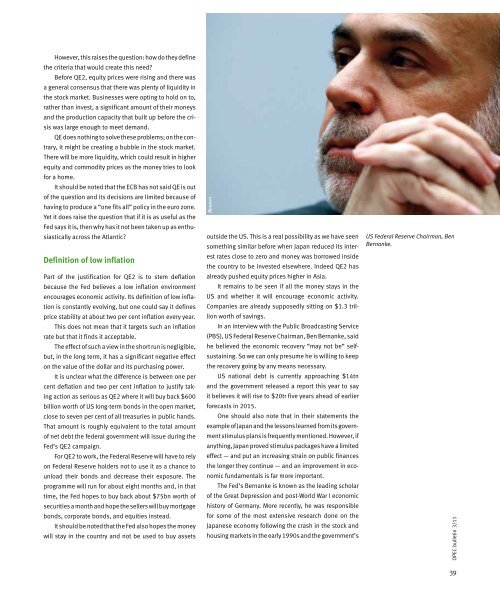OPEC Bulletin January 2009OPEC Bulletin February 2009OPEC ...
OPEC Bulletin January 2009OPEC Bulletin February 2009OPEC ...
OPEC Bulletin January 2009OPEC Bulletin February 2009OPEC ...
Create successful ePaper yourself
Turn your PDF publications into a flip-book with our unique Google optimized e-Paper software.
However, this raises the question: how do they define<br />
the criteria that would create this need?<br />
Before QE2, equity prices were rising and there was<br />
a general consensus that there was plenty of liquidity in<br />
the stock market. Businesses were opting to hold on to,<br />
rather than invest, a significant amount of their moneys<br />
and the production capacity that built up before the crisis<br />
was large enough to meet demand.<br />
QE does nothing to solve these problems; on the contrary,<br />
it might be creating a bubble in the stock market.<br />
There will be more liquidity, which could result in higher<br />
equity and commodity prices as the money tries to look<br />
for a home.<br />
It should be noted that the ECB has not said QE is out<br />
of the question and its decisions are limited because of<br />
having to produce a “one fits all” policy in the euro zone.<br />
Yet it does raise the question that if it is as useful as the<br />
Fed says it is, then why has it not been taken up as enthusiastically<br />
across the Atlantic?<br />
Definition of low inflation<br />
Part of the justification for QE2 is to stem deflation<br />
because the Fed believes a low inflation environment<br />
encourages economic activity. Its definition of low inflation<br />
is constantly evolving, but one could say it defines<br />
price stability at about two per cent inflation every year.<br />
This does not mean that it targets such an inflation<br />
rate but that it finds it acceptable.<br />
The effect of such a view in the short run is negligible,<br />
but, in the long term, it has a significant negative effect<br />
on the value of the dollar and its purchasing power.<br />
It is unclear what the difference is between one per<br />
cent deflation and two per cent inflation to justify taking<br />
action as serious as QE2 where it will buy back $600<br />
billion worth of US long-term bonds in the open market,<br />
close to seven per cent of all treasuries in public hands.<br />
That amount is roughly equivalent to the total amount<br />
of net debt the federal government will issue during the<br />
Fed’s QE2 campaign.<br />
For QE2 to work, the Federal Reserve will have to rely<br />
on Federal Reserve holders not to use it as a chance to<br />
unload their bonds and decrease their exposure. The<br />
programme will run for about eight months and, in that<br />
time, the Fed hopes to buy back about $75bn worth of<br />
securities a month and hope the sellers will buy mortgage<br />
bonds, corporate bonds, and equities instead.<br />
It should be noted that the Fed also hopes the money<br />
will stay in the country and not be used to buy assets<br />
Reuters<br />
outside the US. This is a real possibility as we have seen<br />
something similar before when Japan reduced its interest<br />
rates close to zero and money was borrowed inside<br />
the country to be invested elsewhere. Indeed QE2 has<br />
already pushed equity prices higher in Asia.<br />
It remains to be seen if all the money stays in the<br />
US and whether it will encourage economic activity.<br />
Companies are already supposedly sitting on $1.3 trillion<br />
worth of savings.<br />
In an interview with the Public Broadcasting Service<br />
(PBS), US Federal Reserve Chairman, Ben Bernanke, said<br />
he believed the economic recovery “may not be” selfsustaining.<br />
So we can only presume he is willing to keep<br />
the recovery going by any means necessary.<br />
US national debt is currently approaching $14tn<br />
and the government released a report this year to say<br />
it believes it will rise to $20tr five years ahead of earlier<br />
forecasts in 2015.<br />
One should also note that in their statements the<br />
example of Japan and the lessons learned from its government<br />
stimulus plans is frequently mentioned. However, if<br />
anything, Japan proved stimulus packages have a limited<br />
effect — and put an increasing strain on public finances<br />
the longer they continue — and an improvement in economic<br />
fundamentals is far more important.<br />
The Fed’s Bernanke is known as the leading scholar<br />
of the Great Depression and post-World War I economic<br />
history of Germany. More recently, he was responsible<br />
for some of the most extensive research done on the<br />
Japanese economy following the crash in the stock and<br />
housing markets in the early 1990s and the government’s<br />
US Federal Reserve Chairman, Ben<br />
Bernanke.<br />
<strong>OPEC</strong> bulletin 3/11<br />
39

















